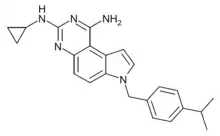 | |
| Identifiers | |
|---|---|
| |
| CAS Number | |
| PubChem CID | |
| ChemSpider | |
| Chemical and physical data | |
| Formula | C23H25N5 |
| Molar mass | 371.488 g·mol−1 |
| 3D model (JSmol) | |
| |
| |
SCH-79797 is a drug which acts as a potent and selective antagonist of the thrombin receptor proteinase activated receptor 1 (PAR1).[1] It has anticoagulant, anticonvulsant and antiinflammatory effects and has been researched as a treatment for heart attack and stroke, though never developed for medical use.[2][3][4][5] It also shows antibiotic actions which are not shared with other PAR1 antagonists such as vorapaxar, so may be mediated through a different target than PAR1.[6][7]
References
- ↑ Ahn HS, Foster C, Boykow G, Stamford A, Manna M, Graziano M (November 2000). "Inhibition of cellular action of thrombin by N3-cyclopropyl-7-{[4-(1-methylethyl)phenyl]methyl}-7H-pyrrolo[3,2-f]quinazoline-1,3-diamine (SCH 79797), a nonpeptide thrombin receptor antagonist". Biochemical Pharmacology. 60 (10): 1425–34. doi:10.1016/s0006-2952(00)00460-3. PMID 11020444.
- ↑ Yang JN, Chen J, Xiao M (February 2017). "A protease-activated receptor 1 antagonist protects against global cerebral ischemia/reperfusion injury after asphyxial cardiac arrest in rabbits". Neural Regeneration Research. 12 (2): 242–249. doi:10.4103/1673-5374.199011. PMC 5361508. PMID 28400806.
- ↑ Semenikhina M, Bogovyk R, Fedoriuk M, Nikolaienko O, Al Kury LT, Savotchenko A, et al. (January 2019). "Inhibition of protease-activated receptor 1 ameliorates behavioral deficits and restores hippocampal synaptic plasticity in a rat model of status epilepticus". Neuroscience Letters. 692: 64–68. doi:10.1016/j.neulet.2018.10.058. PMID 30391321. S2CID 53217829.
- ↑ Pontecorvi P, Banki MA, Zampieri C, Zalfa C, Azmoon P, Kounnas MZ, et al. (December 2019). "Fibrinolysis protease receptors promote activation of astrocytes to express pro-inflammatory cytokines". Journal of Neuroinflammation. 16 (1): 257. doi:10.1186/s12974-019-1657-3. PMC 6896679. PMID 31810478.
- ↑ Yokono Y, Hanada K, Narita M, Tatara Y, Kawamura Y, Miura N, et al. (June 2020). "Blockade of PAR-1 Signaling Attenuates Cardiac Hypertrophy and Fibrosis in Renin-Overexpressing Hypertensive Mice". Journal of the American Heart Association. 9 (12): e015616. doi:10.1161/JAHA.119.015616. PMC 7429042. PMID 32495720.
- ↑ Gupta N, Liu R, Shin S, Sinha R, Pogliano J, Pogliano K, et al. (June 2018). "SCH79797 improves outcomes in experimental bacterial pneumonia by boosting neutrophil killing and direct antibiotic activity". The Journal of Antimicrobial Chemotherapy. 73 (6): 1586–1594. doi:10.1093/jac/dky033. PMC 5961356. PMID 29514266.
- ↑ Martin JK, Sheehan JP, Bratton BP, Moore GM, Mateus A, Li SH, et al. (May 2020). "A Dual-Mechanism Antibiotic Kills Gram-Negative Bacteria and Avoids Drug Resistance". Cell. 181 (7): 1518–1532.e14. doi:10.1016/j.cell.2020.05.005. PMC 7780349. PMID 32497502. S2CID 219300022.
This article is issued from Wikipedia. The text is licensed under Creative Commons - Attribution - Sharealike. Additional terms may apply for the media files.